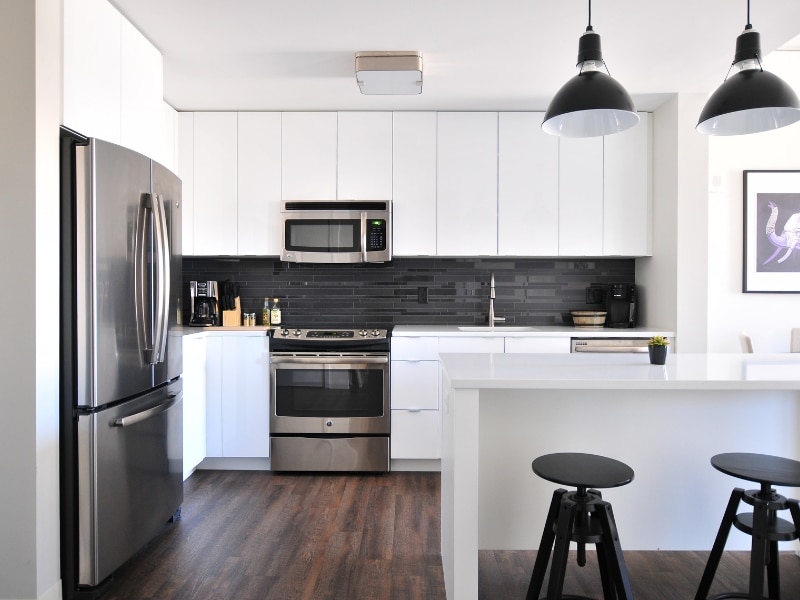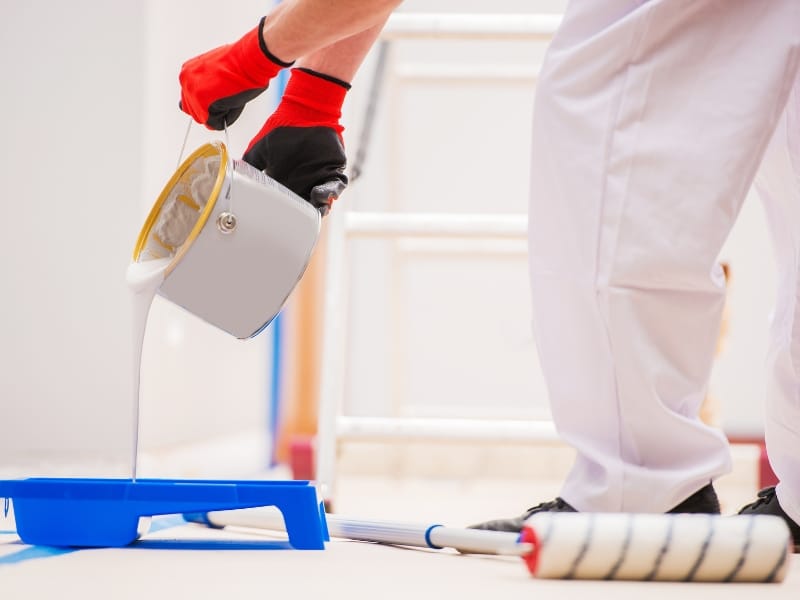Thinking of painting your kitchen? Don’t reckon it’ll be a quick spray-and-go like your lounge or bedroom. Kitchens chuck a few curveballs your way — tight corners, greasy spots, and cupboards everywhere. It ain’t just about slapping on a new colour; it’s about knowing how to handle the mess without losing your rag. This blog will show why kitchen painting’s a tougher gig and how to make it less of a drama.
What specific obstacles make kitchens harder to paint?
Painting a kitchen can catch you out if you’re not ready.
- Cupboards gobble up wall space, and getting paint around hinges and edges is a pain. You’ll be swapping to smaller brushes plenty, and opening doors mid-paint? A real headache. Plus, painting cupboard faces properly takes patience and a steady hand to dodge drips and patchiness.
- Ovens, fridges, and splashbacks don’t budge. They trap dust and grease, making paint stick as well as a wet fish. Grease builds up over time, so cleaning beforehand isn’t just a good idea — it’s a must.
- Tiny windows or poor ventilation mean paint dries slower, and the smell hangs about longer than you want. This can muck up the finish, leaving blotchy patches if moisture’s stuck inside.
- Grease and moisture crust up surfaces over time. Even a good clean sometimes won’t cut it — you might need a special primer to get the paint to stick properly.
Don’t treat your kitchen like any old room. It’s a whole different kettle of fish. A bit of prep now saves you a world of pain later.
Why does kitchen layout complicate the painting process?

It’s not just the walls that cause grief — it’s the whole setup.
- Tight corners in galley or U-shaped kitchens mean you’re painting from awkward angles. Sore arms and uneven patches happen easily if you’re not careful. Sometimes there’s barely room for a ladder or stool, making it even trickier.
- Different materials like tiles, timber, metal, and plasterboard all need their own prep. Some parts need sanding; others need a special primer. You’ll be switching tools and techniques a fair bit, which drags the job out.
- Walls, ceilings, cupboards, trims — sometimes they each need a different finish. Keeping track’s a proper head-scratcher, especially if you’re flying solo. Colour choices and finishes need to gel for a ripper look.
- Areas near stoves or splashbacks aren’t paint-and-go. They need heat-resistant or special primers. Use the wrong paint, and it’ll peel or go funny quick smart. Repainting too soon causes bubbles or discolouration.
This layout tangle is why painting a kitchen often takes longer than painting two other rooms combined. If you’re looking for reliable solutions for kitchen painting projects, take time to understand how the layout impacts the technique.
Can humidity and grease ruin your kitchen painting efforts?
You betcha. Grease and steam are the silent troublemakers.
- Cooking grease leaves invisible films that stop paint from sticking properly. Surfaces that look clean might still hold grease, causing paint to flake or peel soon after drying.
- Steam sneaks into paint layers if walls aren’t sealed well, mucking with drying times and inviting mould to take hold. Kitchens with dodgy ventilation or old windows are the worst offenders.
- Moist spots behind appliances or near windows are mould hotspots. You’ll want a mould inhibitor before painting to keep fungus at bay.
- Paint bubbles and blisters? That’s moisture trapped under fresh paint, especially near benchtops or dishwashers where water’s always about.
Ignoring this will cost you time and money down the track. Controlling humidity and picking the right paint is crucial for a long-lasting job.
How can you prepare your kitchen walls for painting success?

Prep properly to dodge headaches later.
- Degrease everything with sugar soap to cut through oils and food gunk. Don’t skip cupboard doors — grease loves settling there and makes paint peel.
- Fix cracks and holes near benchtops and corners. Sand for a smooth finish. Check skirting boards too for gaps or damage that might show through paint.
- Mask off cupboards and tiles well to avoid messy edges and drips. Use quality painter’s tape and press it down for crisp lines.
- Keep air flowing — open windows and use fans, especially with oil-based primers. Good airflow helps paint dry evenly and cuts fumes, making the job easier and safer.
If you’re unsure about the right technique, start by preparing surfaces for a flawless paint job so that the colour holds and the finish lasts.
What types of paint work best in a kitchen environment?
Picking the right paint is half the battle. The wrong stuff’ll cause you grief.
Paint Type | Best Use Case | Key Benefit | Finish Type |
Washable acrylic | Walls and ceilings | Easy to clean, resists stains | Low sheen |
Enamel-based paint | Cupboards and trims | Tough and moisture resistant | Satin or gloss |
Mould-resistant paint | Near sinks and windows | Stops mould dead in its tracks | Matte or semi |
Heat-resistant paint | Near stoves and ovens | Handles high temps well | Satin or gloss |
- Washable paints are tops for spots you wipe often, like breakfast nooks or dining zones. They handle spills and splashes with ease.
- Paint with stain blockers adds an extra shield against splashes and heat marks, helping your paint last longer.
- Glossy paints clean easily but show every bump; low sheen hides flaws but might soak stains. Your choice depends on how much wear and tear the kitchen gets.
- Food-safe finishes are a must behind open shelves or near prep areas to keep things hygienic and safe.
When choosing durable wall paint within budget, pick products designed for kitchens, not just general interior use.
Is it better to hire a pro for kitchen painting jobs?
Depends on your patience and gear. Kitchens throw curveballs even at keen DIYers.
- Prep and drying can drag on for days or weekends. What you thought’d take a day can stretch into a marathon.
- You’ll need specialist gear — angled brushes, cabinet rollers, maybe a sprayer — to get a smooth finish.
- DIY jobs often miss tricky spots or leave roller marks that are hard to fix once dry. Pros know how to dodge these.
- Check the requirements for NSW kitchen and bathroom renovation work to ensure you’re following proper regulations.
- Paint fumes in tight kitchens can cause headaches or breathing troubles, with VOCs lingering longer than you’d like. Pros use better ventilation and low-VOC paints to keep it safe.
If you’re painting cupboards or ceilings, a pro can save you a heap of hassle and nail the finish.
Final thoughts
Painting a kitchen ain’t a walk in the park. Battling grease, tight corners, and fiddly cabinets calls for patience and solid prep. Good prep, the right paint, and a brilliant game plan make all the difference. And if it all feels too fiddly? See how Sydney Paintmasters can support your repaint project.

